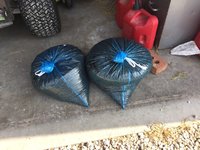Hmmmm.
Last year (2107), a neighbor and I attended the JB seminar at Lincoln U. Following that, we attempted a mass trapping program. It worked, but we couldn't find a use for all the beetles we caught. He had about 6 of the commercial traps and we were getting about 1/2 a 5 gallon bucket per day per trap. He estimated that over the course of the season, he caught at least 3 million beetles. I did about the same with the bag a bug traps. A chicken can only eat about 50 to 100 per day and then they are full. So consuming that many beetles fresh would take a lot of chickens!
So finding a way to save and process these would be a great benefit. The info in this thread is great stuff!
BTW, here are some of the trap mods we used. Starting with the simple Bag A Bug trap and how we modified it to catch more.
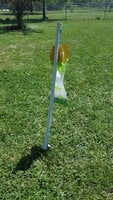
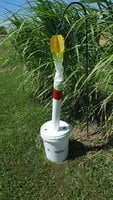
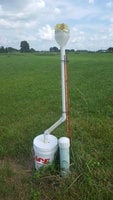
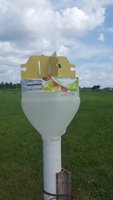
So the bugs crash into the panels and drop down into the funnel, down the pipe and into the bucket.
The pipe (3" PVC sewer pipe) can be longer......it can extend up into the tree canopy, and the bugs will still drop to the bottom.
The problem remains it only catches a small fraction. I tried some experiments with larger funnels.......have one I was going to use this year that was 2' in diameter to up the catch rate. Never got to use it.
A variation on this theme is to let the bugs drop into a small plastic wading pool with water, and bugs will float and chicks snag them that way. I've heard that ducks eat more than chickens, so this may work well for them. Assuming you have a few thousand ducks to feed!
Or hang the trap over the water and let them drop straight into the pond, lake or river. Problem still remains you may overwhelm the ability of the fish to eat them. They can only hold so many before they are full.
Would like to see this tried in a river where the fish population can swell to meet the need.
Last year (2107), a neighbor and I attended the JB seminar at Lincoln U. Following that, we attempted a mass trapping program. It worked, but we couldn't find a use for all the beetles we caught. He had about 6 of the commercial traps and we were getting about 1/2 a 5 gallon bucket per day per trap. He estimated that over the course of the season, he caught at least 3 million beetles. I did about the same with the bag a bug traps. A chicken can only eat about 50 to 100 per day and then they are full. So consuming that many beetles fresh would take a lot of chickens!
So finding a way to save and process these would be a great benefit. The info in this thread is great stuff!
BTW, here are some of the trap mods we used. Starting with the simple Bag A Bug trap and how we modified it to catch more.




So the bugs crash into the panels and drop down into the funnel, down the pipe and into the bucket.
The pipe (3" PVC sewer pipe) can be longer......it can extend up into the tree canopy, and the bugs will still drop to the bottom.
The problem remains it only catches a small fraction. I tried some experiments with larger funnels.......have one I was going to use this year that was 2' in diameter to up the catch rate. Never got to use it.
A variation on this theme is to let the bugs drop into a small plastic wading pool with water, and bugs will float and chicks snag them that way. I've heard that ducks eat more than chickens, so this may work well for them. Assuming you have a few thousand ducks to feed!
Or hang the trap over the water and let them drop straight into the pond, lake or river. Problem still remains you may overwhelm the ability of the fish to eat them. They can only hold so many before they are full.
Would like to see this tried in a river where the fish population can swell to meet the need.



